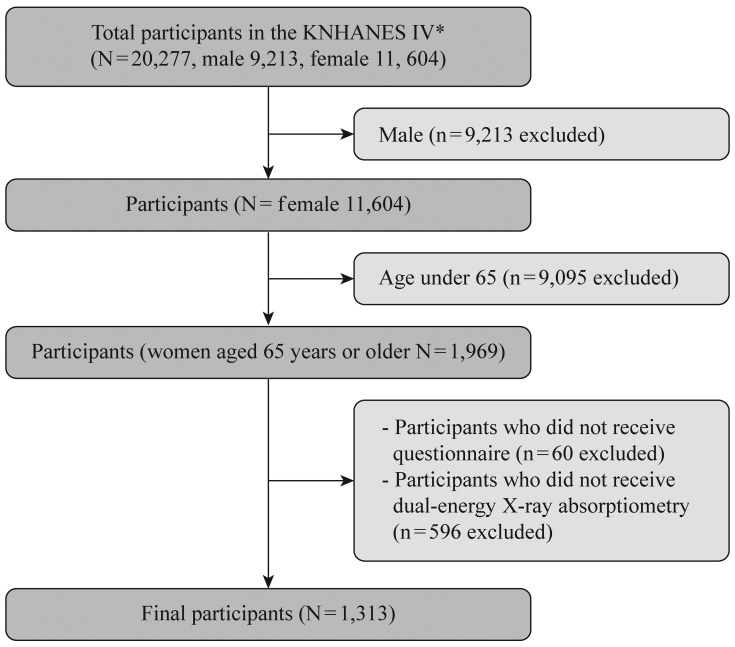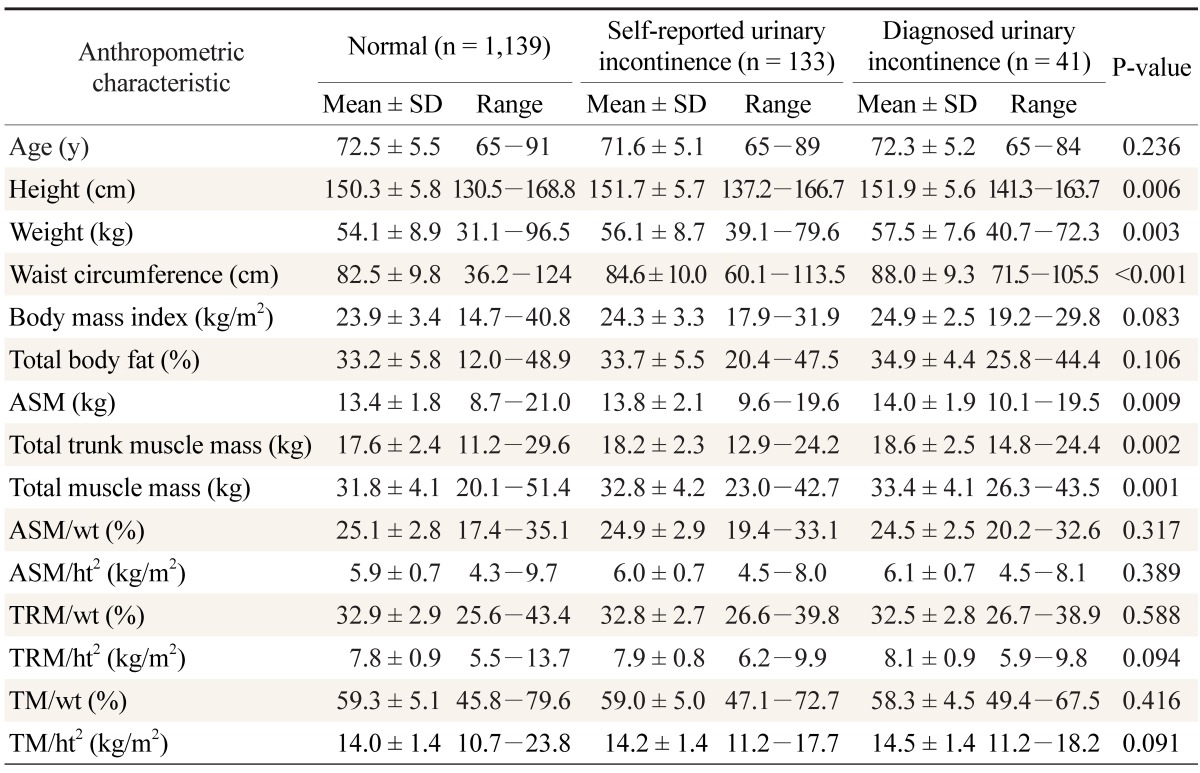1. Kim JH, Hwang Bo Y, Hong ES, Ohn JH, Kim CH, Kim HW, et al. Investigation of sarcopenia and its association with cardiometabolic risk factors in elderly subjects. J Korean Geriatr Soc 2010;14:121-130.

2. Hong S, Choi WH. Clinical and physiopathological mechanism of sarcopenia. Korean J Med 2012;83:444-454.

3. Bijlsma AY, Meskers CG, Westendorp RG, Maier AB. Chronology of age-related disease definitions: osteoporosis and sarcopenia. Ageing Res Rev 2012;11:320-324. PMID:
22306229.


4. Lee S, Kim TN, Kim SH. Sarcopenic obesity is more closely associated with knee osteoarthritis than is nonsarcopenic obesity: a cross-sectional study. Arthritis Rheum 2012;64:3947-3954. PMID:
23192792.


5. Roubenoff R. Sarcopenic obesity: does muscle loss cause fat gain?: lessons from rheumatoid arthritis and osteoarthritis. Ann N Y Acad Sci 2000;904:553-557. PMID:
10865804.


6. Zamboni M, Mazzali G, Fantin F, Rossi A, Di Francesco V. Sarcopenic obesity: a new category of obesity in the elderly. Nutr Metab Cardiovasc Dis 2008;18:388-395. PMID:
18395429.


7. Fielding RA, Vellas B, Evans WJ, Bhasin S, Morley JE, Newman AB, et al. Sarcopenia: an undiagnosed condition in older adults. Current consensus definition: prevalence, etiology, and consequences. International working group on sarcopenia. J Am Med Dir Assoc 2011;12:249-256. PMID:
21527165.



8. Kim NH, Kim HS, Eun CR, Seo JA, Cho HJ, Kim SG, et al. Depression is associated with sarcopenia, not central obesity, in elderly korean men. J Am Geriatr Soc 2011;59:2062-2068. PMID:
22092258.


9. Stephen WC, Janssen I. Sarcopenic-obesity and cardiovascular disease risk in the elderly. J Nutr Health Aging 2009;13:460-466. PMID:
19390754.


10. Lima RM, Bezerra LM, Rabelo HT, Silva MA, Silva AJ, Bottaro M, et al. Fat-free mass, strength, and sarcopenia are related to bone mineral density in older women. J Clin Densitom 2009;12:35-41. PMID:
19084449.


11. Ahn N, Kim K. Strengthening exercise for prevention of sarcopenia during the aging process. Korean J Obes 2012;21:187-196.

12. Lee KS, Sung HH, Na S, Choo MS. Prevalence of urinary incontinence in Korean women: results of a National Health Interview Survey. World J Urol 2008;26:179-185. PMID:
18265989.


13. Coyne KS, Sexton CC, Irwin DE, Kopp ZS, Kelleher CJ, Milsom I. The impact of overactive bladder, incontinence and other lower urinary tract symptoms on quality of life, work productivity, sexuality and emotional well-being in men and women: results from the EPIC study. BJU Int 2008;101:1388-1395. PMID:
18454794.


14. Brown JS, Vittinghoff E, Wyman JF, Stone KL, Nevitt MC, Ensrud KE, et al. Urinary incontinence: does it increase risk for falls and fractures?: study of Osteoporotic Fractures Research Group. J Am Geriatr Soc 2000;48:721-725. PMID:
10894308.


15. Resnick NM, Elbadawi A, Yalla SV. Age and the lower urinary tract: what is normal. Neurourol Urodyn 1995;14:577.
16. Stav K, Alcalay M, Peleg S, Lindner A, Gayer G, Hershkovitz I. Pelvis architecture and urinary incontinence in women. Eur Urol 2007;52:239-244. PMID:
17207915.


17. Kim YS, Lee Y, Chung YS, Lee DJ, Joo NS, Hong D, et al. Prevalence of sarcopenia and sarcopenic obesity in the Korean population based on the Fourth Korean National Health and Nutritional Examination Surveys. J Gerontol A Biol Sci Med Sci 2012;67:1107-1113. PMID:
22431554.


18. Hong S, Choi WH. Clinical and physiopathological mechanism of sarcopenia. Korean J Med 2012;83:444-454.

19. Dwyer PL, Lee ET, Hay DM. Obesity and urinary incontinence in women. Br J Obstet Gynaecol 1988;95:91-96. PMID:
3342213.


20. Thom DH, van den Eeden SK, Brown JS. Evaluation of parturition and other reproductive variables as risk factors for urinary incontinence in later life. Obstet Gynecol 1997;90:983-989. PMID:
9397116.


21. Jackson SL, Scholes D, Boyko EJ, Abraham L, Fihn SD. Urinary incontinence and diabetes in postmenopausal women. Diabetes Care 2005;28:1730-1738. PMID:
15983327.


22. National Institute on Alcohol Abuse and Alcoholism. Helping patients who drink too much: a clinician's guide. Rockville (MD): Department of Health & Human Services, National Institutes of Health, National Institute on Alcohol Abuse and Alcoholism; 2005.
23. Branch LG, Walker LA, Wetle TT, DuBeau CE, Resnick NM. Urinary incontinence knowledge among community-dwelling people 65 years of age and older. J Am Geriatr Soc 1994;42:1257-1262. PMID:
7983288.


24. Hannestad YS, Rortveit G, Sandvik H, Hunskaar S;. Epidemiology of Incontinence in the County of Nord-Trøndelag: a community-based epidemiological survey of female urinary incontinence: the Norwegian EPINCONT study: epidemiology of Incontinence in the County of Nord-Trondelag. J Clin Epidemiol 2000;53:1150-1157. PMID:
11106889.


25. Diokno AC, Brock BM, Brown MB, Herzog AR. Prevalence of urinary incontinence and other urological symptoms in the noninstitutionalized elderly. J Urol 1986;136:1022-1025. PMID:
3490584.


26. Choi JB. Urinary incontinence in women. Korean J Fam Med 2010;31:661-671.

27. Jung HW, Kim SW, Chin HJ, Kim CH, Kim KI. Skeletal muscle mass as a predictor of mortality in the elderly population. Korean J Med 2013;85:167-173.

28. Oh HS, Kim MK. Factors affecting the severity of urinary incontinence and the quality of life of women with urinary incontinence. J Korean Acad Nurs 2005;35:469-477.

29. Subak LL, Wing R, West DS, Franklin F, Vittinghoff E, Creasman JM, et al. Weight loss to treat urinary incontinence in overweight and obese women. N Engl J Med 2009;360:481-490. PMID:
19179316.



30. Subak LL, Whitcomb E, Shen H, Saxton J, Vittinghoff E, Brown JS. Weight loss: a novel and effective treatment for urinary incontinence. J Urol 2005;174:190-195. PMID:
15947625.
















